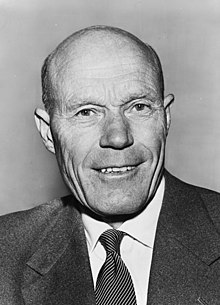Tarjei Vesaas
Tarjei Vesaas | |
|---|---|
 Tarjei Vesaas (1967) | |
| Born | August 20, 1897 Vinje, Telemark, Norway |
| Died | March 15, 1970 (aged 72) Oslo, Norway |
| Language | Nynorsk |
| Nationality | Norwegian |
| Notable awards | Gyldendals legat (1943) Doblougprisen (1957) |
| Spouse | |
| Children | Olav Vesaas Guri Vesaas |
| Relatives | Sven Moren (father-in-law) Sigmund Moren (brother-in-law) |

Tarjei Vesaas (20 August 1897 – 15 March 1970) was a Norwegian poet and novelist. Vesaas is widely considered to be one of Norway's greatest writers of the twentieth century and perhaps its most important since World War II.[1]
Biography
Vesaas was born in Vinje, Telemark, Norway to Olav Vesaas (1870–1951), a farmer and Signe Øygarden (1870–1953), a teacher. [2] He was the oldest of three sons. He was guilt-ridden by his refusal to take over the family farm, and this guilt permeates much of his authorship. He spent much of his youth in solitude, seeking comfort and solace in nature. He married the writer Halldis Moren Vesaas (the daughter of Sven Moren and the sister of Sigmund Moren) and moved to Midtbø in his home district of Vinje in 1934. They had two children: a son, Olav Vesaas and a daughter, Guri Vesaas. [3][4]
His authorship covers almost 50 years, from 1923 to 1970. Written in
A prolific author, he won a number of awards, including the
The most famous of his works are The Ice Palace (Is-slottet), a story of two girls who build a profoundly strong relationship, and The Birds (Fuglane), a story of an adult of a simple childish mind, which through his tenderhearted empathy and imagination bears the role of a seer or writer. His novels have been translated into 28 languages. Several of his books have been translated into English – many of them published by Peter Owen Publishers– among them Spring Night, The Birds, Through Naked Branches, and The Ice Palace.[7]
Awards
- 1943 – Gyldendal's Endowment (Gyldendals legat)
- 1946 – Melsom Prize (Melsom-prisen)
- 1957 – Dobloug Prize (Doblougprisen)
- 1964 – Nordic Council's Literature Prize(Nordisk råds litteraturpris)
- 1967 – Norwegian Booksellers' Prize (Bokhandlerprisen)
Selected works
Novels
- Menneskebonn (Children of Man, 1923)
- Sendemann Huskuld (Huskuld the Herald, 1924)
- Dei svarte hestane (The Black Horses, 1928)
- Sandeltreet (The Sandalwood, 1933)
- Kimen (The Seed, 1940)
- Translated by Kenneth G. Chapman (Peter Owen Publishers, 1964)
- Huset i mørkret (The House in the Dark, 1945)
- Translated by Elizabeth Rokkan (Peter Owen Publishers, 1976)
- Bleikeplassen (The Bleaching Place, 1946)
- Translated by Elizabeth Rokkan (Peter Owen Publishers, 1981); published as The Bleaching Yard
- Tårnet (The Tower, 1948)
- Signalet (The Signal, 1950)
- Vårnatt (Spring Night, 1954)
- Translated by Kenneth G. Chapman (Peter Owen Publishers, 1972)
- Fuglane (The Birds, 1957)
- Translated by Torbjørn Støverud and Michael Barnes (Peter Owen Publishers, 1968)
- Brannen (The Fire, 1961)
- Is-slottet (The Ice Palace, 1963)
- Translated by Elizabeth Rokkan (Peter Owen Publishers, 1993)
- Bruene (The Bridges, 1966)
- Translated by Elizabeth Rokkan (Peter Owen Publishers, 1969)
- Båten om Kvelden (The Boat in the Evening, 1968)
- Translated by Elizabeth Rokkan (Peter Owen Publishers, 1971)
Grinde Farm series
- Grindegard: Morgonen (Grinde Farm, 1925)
- Grinde‐kveld, eller Den gode engelen (Evening at Grinde, 1926)
Klas Dyregodt series
- Fars reise (Father's Journey, 1930)
- Sigrid Stallbrokk (1931)
- Dei ukjende mennene (The Unknown Men, 1932)
- Hjarta høyrer sine heimlandstonar (The Heart Hears Its Native Music, 1938)
The Great Cycle series
- Det store spelet (The Great Cycle, 1934)
- Translated by Elizabeth Rokkan (University of Wisconsin Press, 1967)
- Kvinnor ropar heim (Women Call Home, 1935)
Poetry
- Kjeldene (The Springs, 1946)
- Leiken og lynet (The Game and the Lightning, 1947)
- Lykka for ferdesmenn (Wanderers’ Happiness, 1949)
- Løynde eldars land (Land of Hidden Fires, 1953)
- Translated by Fritz König and Jerry Crisp (Wayne State University Press, 1973)
- Ver ny, vår draum (May Our Dream Stay New, 1956)
- Liv ved straumen (Life by the Stream, 1970)
Short story collections
- Klokka i haugen (The Bell in the Mound, 1929)
- Leiret og hjulet (The Clay and the Wheel, 1936)
- Vindane (The Winds, 1952)
- Ein vakker dag (A Lovely Day, 1959)
Plays
- Guds bustader (God’s Abodes, 1925)
- Ultimatum (1934)
- Morgonvinden (Morning Wind, 1947)
See also
References
- ^ "Nomination Database". www.nobelprize.org. Retrieved 2017-01-23.
- ^ Gimnes, Steinar (2020-02-25), "Tarjei Vesaas", Norsk biografisk leksikon (in Norwegian Bokmål), retrieved 2020-10-21
- ^ Erik Bjerck Hagen. "Tarjei Vesaas". Store norske leksikon. Retrieved April 1, 2018.
- ^ "Halldis Moren Vesaas". Aschehoug. Retrieved April 1, 2018.
- ^ Steinar Gimnes. "Tarjei Vesaas". Norsk biografisk leksikon. Retrieved April 1, 2018.
- ^ "Tarjei Vesaas - Nomination Database". www.nobelprize.org. Retrieved 2022-06-29.
- ^ "tarjei Vesaas (1897-1970)". Gyldendal Norsk Forlag AS. Retrieved April 1, 2018.
Other sources
- Kenneth Garnier Chapman (1970) Tarjei Vesaas (Twayne Publishers)
Related reading
- Encyclopedia of World Literature in the 20th Century, vol. 4, ed. S. R. Serafin, 1999;
- Columbia Dictionary of Modern European Literature, ed. Jean-Albert Bédé & William B. Edgerton, 1980;
